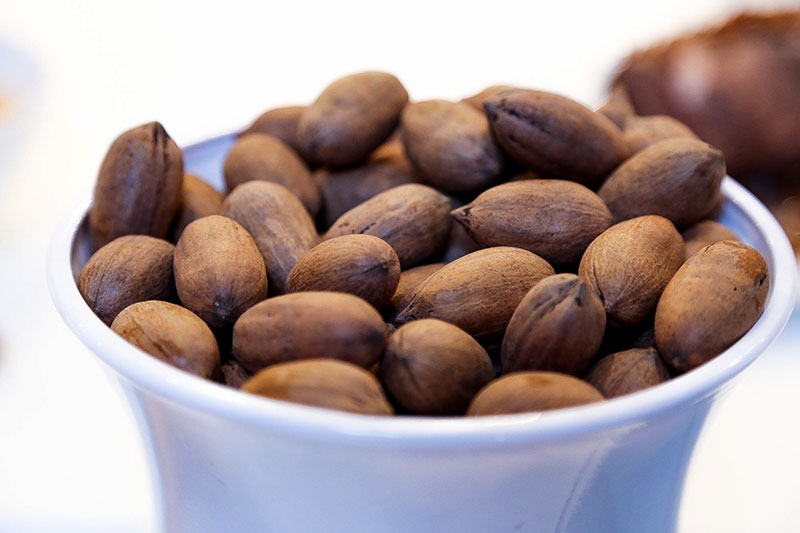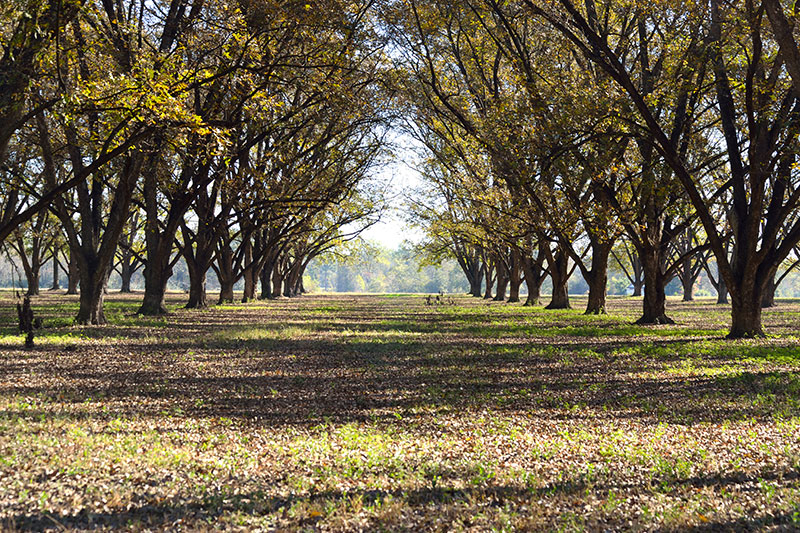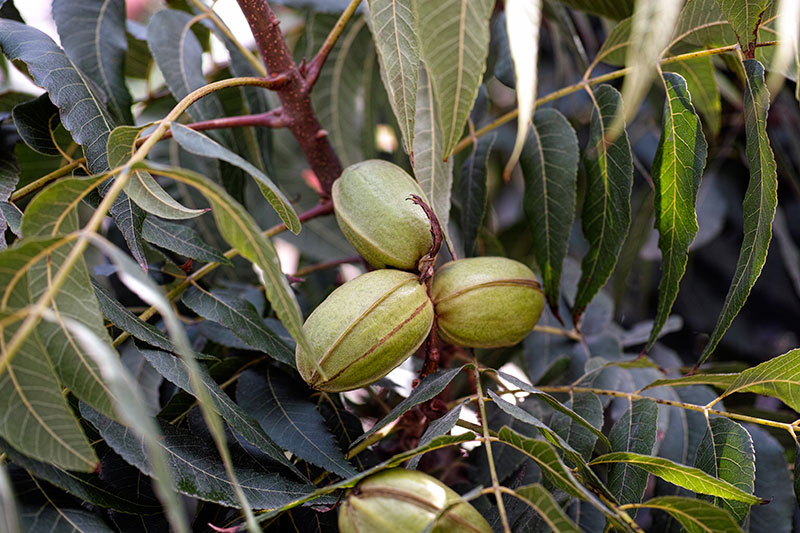Are Americans About to Go Nuts for Pecans?
New research suggests that one of our most antioxidant-rich nuts, the pecan, may be even better for us than we first imagined.
Are Americans About to Go Nuts for Pecans?
New research suggests that one of our most antioxidant-rich nuts, the pecan, may be even better for us than we first imagined.

One of the few tree nuts indigenous to North America, pecans are vitamin and mineral powerhouses, providing thiamine, folate, magnesium, calcium, potassium, and zinc, while also containing cholesterol-lowering omega-6 and omega-3 fatty acids. They’re loaded with antioxidants and an oil content containing surprisingly high levels of oleic acid – the same heart-healthy monounsaturated fatty acid found in olives. Additionally, laboratory tests reveal that gamma-tocopherol, the form of vitamin E found in pecans, has been shown to inhibit prostate cancer cells while not affecting healthy tissues.
There is also evidence that the high levels of antioxidants in pecans may play a role in protecting the nervous system and delaying the progression of degenerative conditions such as Alzheimer’s disease or amyotrophic lateral sclerosis (ALS).
So what does all this research mean for pecan growers and lovers?
A Powerful Dietary Tool
Luis Cisneros-Zevallos, Ph.D., an associate professor of food science and nutrition at Texas A&M University, is nearing the final phase of a two-year study into the pecan’s anti-inflammatory properties. Results so far have shown that pecans decrease fat accumulation in fat cells and reduce inflammation in cells, which makes them potentially useful for the treatment of obesity, and even the prevention of diseases such as cancer.
Stress and disorders can lead to high levels of free radicals in the body. These are reactive molecules that contribute to tissue damage. When free radicals increase, they may induce inflammation, which Cisneros-Zevallos calls “the mother of all big problems you will encounter in diseases, like diabetes, cancer, and Alzheimer’s.” Consuming antioxidants, then, such as those provided by pecans, can reduce levels of these free radicals, and in doing so, reduce inflammation, helping prevent these diseases.
Cisneros-Zevallos and his team are now trying to understand how the chemical compounds in pecans – specifically, polyphenols, those antioxidant-rich phytochemicals believed to protect against some health problems and the effects of aging – may affect Type 2 diabetes. “When people consume these nuts, they’re consuming a product loaded with beneficial chemical compounds,” Cisneros-Zevallos says. “Pecans are rich [in polyphenols] compared to other nuts. All nuts are good, but pecans apparently have more of these beneficial compounds.”
Yet pecans, like most nuts, are also high in calories (a whopping 684 calories per cup!), and for this reason those who watch their weight may want to eat them in moderation. The American Heart Association recommends four to five servings (â…“ cup or 1.5 ounces per serving) of nuts, seeds, or legumes per week as part of a balanced diet, although researchers performing laboratory studies at the University of Massachusetts Lowell found that eating pecans may play a role in protecting the nervous system. In any case, the Mayo Clinic suggests raw or dry-roasted nuts rather than those cooked in oil, and adds that pecans and others nuts make an excellent substitute for saturated fats, such as those found in meats, eggs, and dairy products.

Planting for the Future
Getting the word out about pecan’s many health benefits hasn’t been easy. Compared to the two billion pounds of almonds produced in the U.S. each year, pecans are something of a specialty crop, with an annual U.S. harvest averaging 280 million pounds (in-shell basis), according to Daniel Zedan of Nature’s Finest Foods, Ltd., a firm specializing in the marketing of tree nuts. This disparity explains why we hear so much more about almonds. “The sheer volume of the almond crop generates $20-$35 million a year for promotion,” Zedan says. “Pecans can’t compete dollar for dollar with almonds or walnuts.”
Things are looking up, however. In May 2016, the U.S. Department of Agriculture announced the approval of a Federal Marketing Order that will, among other things, provide funding for the organized promotion of pecans similar to that for pistachios, almonds, and other tree nuts.
To meet the expected increase in demand, growers across the country have planted thousands of acres of new trees in recent years. While the exact amount of new acreage is nearly impossible to determine simply because it’s not clear how many of these plantings were intended to replace or rejuvenate existing orchards – and also because of the unclear distinction between managed orchards and hobby farms – estimates place the number for Georgia, alone, at roughly nearly 25,000 new acres over the past five years. And it’s much the same in the Southwest.
“Just in our area, several thousand new acres have been put in recently,” says John White, of the Western Pecan Growers Association in New Mexico. “This is also the case in Arizona.”
Ditto for the Lone Star State, where Cindy Wise of the Texas Pecan Growers Association says the nursery business is booming.
Throughout the pecan belt, from Florida to California, there is a sense of optimism for what the Federal Marketing Order can do for the industry.
Not surprisingly, these are already some of the nation’s top pecan producing states. The USDA reports that for 2015, leaders in utilized production included Georgia (93 million pounds), New Mexico (73 million), Texas (35 million), Arizona (22.5 million), and Oklahoma (13 million). Throughout the pecan belt, from Florida to California, there is a sense of optimism for what the Federal Marketing Order can do for the industry. In addition to new plantings, growers everywhere are better managing existing trees, some of which have traditionally been neglected during periods of low pecan prices. As a result, the U.S. pecan crop could increase considerably in coming years – by as much as 50 percent, according to Wise, who also told me that such a surge in production would be sustainable thanks to today’s superior tree-management practices.
Hilton Segler, executive director of the National Pecan Growers Council, says that production could even exceed the banner year the industry saw in 2007, when in-shell exports to China surged to 22,000 metric tons, up from six thousand the previous year. Exports have risen more or less steadily ever since, although a myriad of market factors, including the value of the U.S. dollar relative to other world currencies, as well as the inherent, alternate-bearing tendency of pecan trees themselves – in which heavy crops one year are balanced by lighter crops the next – make future production and export values difficult to predict. Regardless, Segler says consumers could start paying more for these nuts in coming years.
“Not a large increase probably,” Segler says. “They’re pretty high now. I’ve seen pecans selling for anywhere from $10 to $15 a pound. But as demand increases, prices for pecans, or any commodity, will go up somewhat.”
The danger, of course, is in overpricing pecans. Although many believe there is no substitute for this nut in a recipe that calls for it, consumers certainly have the choice of whether to buy nuts at all. Price the crop too low and there’s always room for growth. Too high, and bakers might modify their chopped-pecan recipes with a different nut, or avoid them altogether. Where is the threshold?
“We’re getting pretty close to it now,” says one of the pecan growers I spoke to.

Introducing More Americans to Pecans
The projections for increased pecan production underscore the need for better promotion. Simply put, the pecan industry needs more consumers for the anticipated surge in its product supply. This is one of the main reasons behind the formation of the Federal Marketing Order, which the industry believes will benefit growers with better prices, while also increasing public awareness about pecans, especially here in the United States.
Alex Willson, chief operating officer at Sunnyland Farms, in Albany, Georgia, recently represented his company at the International Restaurant and Foodservice Show of New York, where he introduced visitors to pecans, many for the first time. “Some visitors would come up and they didn’t know anything about pecans,” Willson told me during a recent visit.
“I think pecans are going to be the next big thing. They’re native to the U.S. They’re a unique food, and very beneficial for our health. We should be proud of that.”
Fortunately, this is changing. The new Federal Marketing Order is designed for the organized promotion of pecans in the domestic market, something that, until now, hasn’t been done. “We’re going to see a considerable amount of domestic promotion,” says Wise. “There’s a tremendous potential to increase domestic consumption.”
Segler agrees. “This is where the real market is, more so than internationally,” he says. “We feel that demand is not even close to where it will be in the future. There are so many health benefits to eating pecans. We believe they have a very bright future.”
So does Cisneros-Zevallos at Texas A&M University. “Until recently, nobody was paying much attention to pecans,” he explains. “For some reason they were under the radar. But with research revealing their ability to be such a powerful dietary tool, pecans are going to have the attention they deserve.”
And the funding and additional support provided by the Federal Marketing Order federal marketing order promises to amplify this message. “I think pecans are going to be the next big thing,” Cisneros-Zevallos told me. “They’re native to the U.S. They’re a unique food, and very beneficial for our health. We should be proud of that.”
Follow us
This work is licensed under a Creative Commons Attribution-NoDerivatives 4.0 International License.
Want to republish a Modern Farmer story?
We are happy for Modern Farmer stories to be shared, and encourage you to republish our articles for your audience. When doing so, we ask that you follow these guidelines:
Please credit us and our writers
For the author byline, please use “Author Name, Modern Farmer.” At the top of our stories, if on the web, please include this text and link: “This story was originally published by Modern Farmer.”
Please make sure to include a link back to either our home page or the article URL.
At the bottom of the story, please include the following text:
“Modern Farmer is a nonprofit initiative dedicated to raising awareness and catalyzing action at the intersection of food, agriculture, and society. Read more at <link>Modern Farmer</link>.”
Use our widget
We’d like to be able to track our stories, so we ask that if you republish our content, you do so using our widget (located on the left hand side of the article). The HTML code has a built-in tracker that tells us the data and domain where the story was published, as well as view counts.
Check the image requirements
It’s your responsibility to confirm you're licensed to republish images in our articles. Some images, such as those from commercial providers, don't allow their images to be republished without permission or payment. Copyright terms are generally listed in the image caption and attribution. You are welcome to omit our images or substitute with your own. Charts and interactive graphics follow the same rules.
Don’t change too much. Or, ask us first.
Articles must be republished in their entirety. It’s okay to change references to time (“today” to “yesterday”) or location (“Iowa City, IA” to “here”). But please keep everything else the same.
If you feel strongly that a more material edit needs to be made, get in touch with us at [email protected]. We’re happy to discuss it with the original author, but we must have prior approval for changes before publication.
Special cases
Extracts. You may run the first few lines or paragraphs of the article and then say: “Read the full article at Modern Farmer” with a link back to the original article.
Quotes. You may quote authors provided you include a link back to the article URL.
Translations. These require writer approval. To inquire about translation of a Modern Farmer article, contact us at [email protected]
Signed consent / copyright release forms. These are not required, provided you are following these guidelines.
Print. Articles can be republished in print under these same rules, with the exception that you do not need to include the links.
Tag us
When sharing the story on social media, please tag us using the following: - Twitter (@ModFarm) - Facebook (@ModernFarmerMedia) - Instagram (@modfarm)
Use our content respectfully
Modern Farmer is a nonprofit and as such we share our content for free and in good faith in order to reach new audiences. Respectfully,
No selling ads against our stories. It’s okay to put our stories on pages with ads.
Don’t republish our material wholesale, or automatically; you need to select stories to be republished individually.
You have no rights to sell, license, syndicate, or otherwise represent yourself as the authorized owner of our material to any third parties. This means that you cannot actively publish or submit our work for syndication to third party platforms or apps like Apple News or Google News. We understand that publishers cannot fully control when certain third parties automatically summarize or crawl content from publishers’ own sites.
Keep in touch
We want to hear from you if you love Modern Farmer content, have a collaboration idea, or anything else to share. As a nonprofit outlet, we work in service of our community and are always open to comments, feedback, and ideas. Contact us at [email protected].by John Gifford, Modern Farmer
September 21, 2016
Modern Farmer Weekly
Solutions Hub
Innovations, ideas and inspiration. Actionable solutions for a resilient food system.
ExploreExplore other topics
Share With Us
We want to hear from Modern Farmer readers who have thoughtful commentary, actionable solutions, or helpful ideas to share.
SubmitNecessary cookies are absolutely essential for the website to function properly. This category only includes cookies that ensures basic functionalities and security features of the website. These cookies do not store any personal information.
Any cookies that may not be particularly necessary for the website to function and are used specifically to collect user personal data via analytics, ads, other embedded contents are termed as non-necessary cookies.
We are considering establishing a 20 acre farm of Olive, melons, nuts in north eastern GA. We are interested in the articles Mod Farm offers on various crops.